BY MIKA NAGAMOTO
A unique aspect of this abroad program is the opportunity to be in the field where healthcare systems are implemented. The field of global health encompasses a wide range of different focuses ranging from infectious diseases, to environmental impacts on health, to chronic non-infectious diseases, and many other issues that both directly and indirectly affect human health. One commonality amongst all of these global health focuses is the movement towards creating accessible and equal healthcare on a global scale. In order to make positive changes it’s necessary to go to the local area that is most impacted by the health issue of interest.
Starting in the 1980’s, Peru experienced internal terrorism sparked by the communist party in Peru called the “Sendero Luminoso” (the Shining Path). The Sendero Luminoso used guerilla warfare to create internal conflict, particularly in Andeas Highlands. Pampas is a community in the Lima region that was created due to mass migration of Peruvians in the highlands trying to escape the violence created by the conflict between Sendero Luminoso and the government of Peru. Although the internal conflict ended in the early 1990’s, the effects of violence and trauma are still prevalent in areas throughout Peru.

Visiting Pampas revealed the hindering of development created by internal conflict, structural violence, and poverty. After departing from our comfortable and safe hotel in Miraflores, seeing Pampas was a stark comparison and a humbling experience. This community was formed on land that had no infrastructure or public services such as water, electricity, or plumbing. In order to receive these basic necessities, the community had to come together, gather their funds, and advocate for their own needs. Shadows of past violence linger in the areas left un-built due to the concern that land mines may have been left over by the Sendero Luminoso.
Community members, non-governmental organizations, and healthcare centers, are all working towards providing sufficient and accessible healthcare for the community. Visiting health posts and health centers revealed the high demand for healthcare and the limited resources that are available. The healthcare centers are dedicated to providing care for all those in need regardless of whether or not they are able to afford it. However, long lines and limited hours serve as barriers to reach all of the individuals that seek healthcare.

Wealthier neighborhoods in Lima choose to go to private health centers where they receive optimal care and have the choice of when they go into the clinic. However, the majority of the population in Lima lives in similar neighborhoods as Pampas where poverty, a history of violence, environmental pollution, and limited healthcare create obstacles for the community’s quality of life.
Pampas is just one of many examples in which disparities are created by a cycle of structural violence and poverty. Walking through the streets of Pampas created a vivid and lastly effect on my understanding of global health. Reading about statistics and numbers may allow students to scrape the surface of understanding communities that experience disparities. Yet, the numbers do not capture the depth and complexities of these local contexts. This trip to Pampas puts my own privilege into perspective and gave me important insights into the challenges that public health and healthcare workers face.
The healthcare workers and community leaders in Pampas are passionate and driven to create change within their community, to empower their neighbors, and provide the healthcare that they deserve as a basic human right. I am thankful for the opportunity to have met some of these influential actors and to view the positive changes they are fighting for.
Mika Nagamoto studied abroad in Lima and Iquitos, Peru, in summer 2018: https://ieo.ucla.edu/travelstudy/GlobalHealth-Lima/



